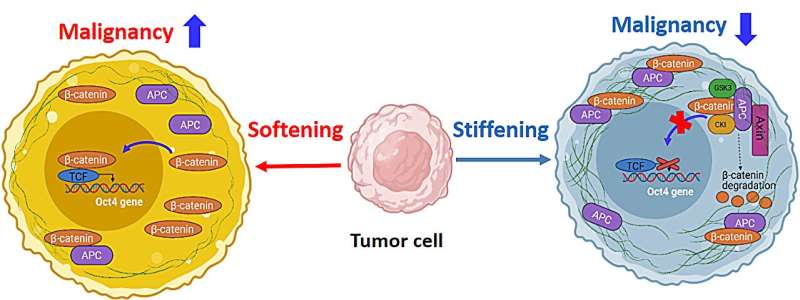This article has been reviewed according to Science X's editorial process and policies. Editors have highlighted the following attributes while ensuring the content's credibility:
fact-checked
peer-reviewed publication
proofread
New insights into the roles of cell mechanics in tumor malignancy

Cancer, as a life-threatening disease, has been a major research focus. Understanding the mechanisms of tumor progression has been a significant challenge. In recent years, increasing evidence has indicated a correlation between the mechanical properties of tumor cells and tumor progression and malignancy.
However, the relationship between tumor cell mechanics and malignancy remains incompletely understood. To address this knowledge gap, Dr. Youhua Tan's team from The Hong Kong Polytechnic University discovered the regulatory roles of tumor cell mechanics in malignancy and unveiled the underlying mechanisms.
Dr. Tan's study demonstrated that moderate softening of tumor cells through targeting the actin cytoskeleton and myosin activity enhanced their self-renewal and tumor formation abilities, while cell stiffening suppressed these abilities across various types of cancer.
Mechanistically, softening/stiffening of the actin cytoskeleton weakened/strengthened the interaction between the tumor suppressor adenomatous polyposis coli (APC) and β-catenin, resulting in nuclear/cytoplasmic localization of β-catenin.
Nuclear-localized β-catenin binds to the promoter region of the Oct4 gene, promoting key gene transcription and maintaining the self-renewal ability of tumor cells. Conversely, cytoplasmic retention of β-catenin led to its degradation and subsequent inactivation of Wnt/β-catenin signaling, reducing the stemness of tumor cells.
Furthermore, cellular mechanics regulated the interconversion between tumor stem cells and non-tumor stem cells, a process dependent on Wnt signaling. In summary, this study demonstrated that actomyosin-mediated cellular mechanics drove tumor cells' self-renewal and tumor-forming abilities through the cytoskeleton/APC/Wnt/β-catenin/Oct4 signaling pathway. These findings have been clinically validated and significantly correlate with the survival of cancer patients.
The discoveries from this study provide a new perspective for a deep understanding of tumor progression and offer important clues for developing new therapeutic approaches that target tumor cell mechanics. This study demonstrates, for the first time, that tumor cell softening during progression is not merely a consequence of tumor evolution but also a key driving force for tumor development.
This research opens up new avenues for developing new mechanomedicines for cancer prevention and treatment.
The work is published in the journal Research.
More information: Xi Chen et al, The Mechanics of Tumor Cells Dictate Malignancy via Cytoskeleton-Mediated APC/Wnt/β-Catenin Signaling, Research (2023). DOI: 10.34133/research.0224



















